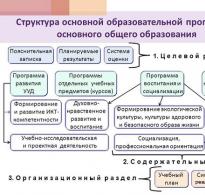Human chromosomes. Interesting facts about human chromosomes Deviations in karyotype
Scheme of chromosome structure in late prophase and metaphase of mitosis. 1 chromatid; 2 centromeres; 3 short shoulder; 4 long shoulder ... Wikipedia
I Medicine Medicine is a system of scientific knowledge and practical activities, the goals of which are to strengthen and preserve health, prolong the life of people, prevent and treat human diseases. To accomplish these tasks, M. studies the structure and... ... Medical encyclopedia
The branch of botany concerned with the natural classification of plants. Specimens with many similar characteristics are grouped into groups called species. Tiger lilies are one type, white lilies are another, etc. Species similar to each other, in turn... ... Collier's Encyclopedia
ex vivo genetic therapy- * ex vivo gene therapy * ex vivo gene therapy based on the isolation of the patient's target cells, their genetic modification under cultivation conditions and autologous transplantation. Genetic therapy using germline... ... Genetics. encyclopedic Dictionary
Animals, plants and microorganisms are the most common objects of genetic research.1 Acetabularia acetabularia. A genus of unicellular green algae of the siphon class, characterized by a giant (up to 2 mm in diameter) nucleus... ... Molecular biology and genetics. Dictionary.
Polymer- (Polymer) Definition of polymer, types of polymerization, synthetic polymers Information about the definition of polymer, types of polymerization, synthetic polymers Contents Contents Definition Historical background Science of Polymerization Types ... ... Investor Encyclopedia
A special qualitative state of the world is perhaps a necessary step in the development of the Universe. A naturally scientific approach to the essence of life is focused on the problem of its origin, its material carriers, the difference between living and nonliving things, and evolution... ... Philosophical Encyclopedia
From school biology textbooks, everyone has become familiar with the term chromosome. The concept was proposed by Waldeyer in 1888. It literally translates as painted body. The first object of research was the fruit fly.
General information about animal chromosomes
A chromosome is a structure in the cell nucleus that stores hereditary information. They are formed from a DNA molecule that contains many genes. In other words, a chromosome is a DNA molecule. Its amount varies among different animals. So, for example, a cat has 38, and a cow has 120. Interestingly, earthworms and ants have the smallest numbers. Their number is two chromosomes, and the male of the latter has one.

In higher animals, as well as in humans, the last pair is represented by XY sex chromosomes in males and XX in females. It should be noted that the number of these molecules is constant for all animals, but their number differs in each species. For example, we can consider the content of chromosomes in some organisms: chimpanzees - 48, crayfish - 196, wolves - 78, hare - 48. This is due to the different level of organization of a particular animal.
On a note! Chromosomes are always arranged in pairs. Geneticists claim that these molecules are the elusive and invisible carriers of heredity. Each chromosome contains many genes. Some believe that the more of these molecules, the more developed the animal, and the more complex its body is. In this case, a person should have not 46 chromosomes, but more than any other animal.
How many chromosomes do different animals have?
You need to pay attention! In monkeys, the number of chromosomes is close to that of humans. But the results are different for each species. So, different monkeys have the following number of chromosomes:
- Lemurs have 44-46 DNA molecules in their arsenal;
- Chimpanzees – 48;
- Baboons – 42,
- Monkeys – 54;
- Gibbons – 44;
- Gorillas – 48;
- Orangutan – 48;
- Macaques - 42.
The canine family (carnivorous mammals) has more chromosomes than monkeys.
- So, the wolf has 78,
- the coyote has 78,
- the small fox has 76,
- but the ordinary one has 34.
- The predatory animals lion and tiger have 38 chromosomes.
- The cat's pet has 38, while his dog opponent has almost twice as many - 78.
In mammals that are of economic importance, the number of these molecules is as follows:
- rabbit – 44,
- cow – 60,
- horse – 64,
- pig – 38.
Informative! Hamsters have the largest chromosome sets among animals. They have 92 in their arsenal. Also in this row are hedgehogs. They have 88-90 chromosomes. And kangaroos have the smallest amount of these molecules. Their number is 12. A very interesting fact is that the mammoth has 58 chromosomes. Samples were taken from frozen tissue.
For greater clarity and convenience, data from other animals will be presented in the summary.
Name of animal and number of chromosomes:
| Spotted martens | 12 |
| Kangaroo | 12 |
| Yellow marsupial mouse | 14 |
| Marsupial anteater | 14 |
| Common opossum | 22 |
| Opossum | 22 |
| Mink | 30 |
| American badger | 32 |
| Corsac (steppe fox) | 36 |
| Tibetan fox | 36 |
| Small panda | 36 |
| Cat | 38 |
| a lion | 38 |
| Tiger | 38 |
| Raccoon | 38 |
| Canadian beaver | 40 |
| Hyenas | 40 |
| House mouse | 40 |
| Baboons | 42 |
| Rats | 42 |
| Dolphin | 44 |
| Rabbits | 44 |
| Human | 46 |
| Hare | 48 |
| Gorilla | 48 |
| American fox | 50 |
| striped skunk | 50 |
| Sheep | 54 |
| Elephant (Asian, savannah) | 56 |
| Cow | 60 |
| Domestic goat | 60 |
| Woolly monkey | 62 |
| Donkey | 62 |
| Giraffe | 62 |
| Mule (hybrid of a donkey and a mare) | 63 |
| Chinchilla | 64 |
| Horse | 64 |
| Gray fox | 66 |
| White-tailed deer | 70 |
| Paraguayan fox | 74 |
| Small fox | 76 |
| Wolf (red, ginger, maned) | 78 |
| Dingo | 78 |
| Coyote | 78 |
| Dog | 78 |
| Common jackal | 78 |
| Chicken | 78 |
| Pigeon | 80 |
| Turkey | 82 |
| Ecuadorian hamster | 92 |
| Common lemur | 44-60 |
| Arctic fox | 48-50 |
| Echidna | 63-64 |
| Jerzy | 88-90 |
Number of chromosomes in different animal species
As you can see, each animal has a different number of chromosomes. Even among representatives of the same family, indicators differ. We can look at the example of primates:
- the gorilla has 48,
- the macaque has 42, and the marmoset has 54 chromosomes.
Why this is so remains a mystery.
How many chromosomes do plants have?
Plant name and number of chromosomes:
Video
Chromosome is a thread-like structure containing DNA in the cell nucleus, which carries genes, units of heredity, arranged in a linear order. Humans have 22 pairs of regular chromosomes and one pair of sex chromosomes. In addition to genes, chromosomes also contain regulatory elements and nucleotide sequences. They house DNA-binding proteins that control DNA functions. Interestingly, the word "chromosome" comes from the Greek word "chrome", meaning "color". Chromosomes received this name because they have the peculiarity of being colored in different tones. The structure and nature of chromosomes vary from organism to organism. Human chromosomes have always been a subject of constant interest to researchers working in the field of genetics. The wide range of factors that are determined by human chromosomes, the abnormalities for which they are responsible, and their complex nature have always attracted the attention of many scientists.
Interesting facts about human chromosomes
Human cells contain 23 pairs of nuclear chromosomes. Chromosomes are made up of DNA molecules that contain genes. The chromosomal DNA molecule contains three nucleotide sequences required for replication. When chromosomes are stained, the banded structure of mitotic chromosomes becomes apparent. Each strip contains numerous DNA nucleotide pairs.
Humans are a sexually reproducing species with diploid somatic cells containing two sets of chromosomes. One set is inherited from the mother, while the other is inherited from the father. Reproductive cells, unlike body cells, have one set of chromosomes. Crossing over between chromosomes leads to the creation of new chromosomes. New chromosomes are not inherited from either parent. This accounts for the fact that not all of us exhibit traits that we receive directly from one of our parents.
Autosomal chromosomes are assigned numbers from 1 to 22 in descending order as their size decreases. Each person has two sets of 22 chromosomes, an X chromosome from the mother and an X or Y chromosome from the father.
An abnormality in the contents of a cell's chromosomes can cause certain genetic disorders in people. Chromosomal abnormalities in people are often responsible for the occurrence of genetic diseases in their children. Those who have chromosomal abnormalities are often only carriers of the disease, while their children develop the disease.

Chromosomal aberrations (structural changes in chromosomes) are caused by various factors, namely deletion or duplication of part of a chromosome, inversion, which is a change in the direction of a chromosome to the opposite, or translocation, in which part of a chromosome is torn off and attached to another chromosome.
An extra copy of chromosome 21 is responsible for a very well known genetic disorder called Down syndrome.
Trisomy 18 results in Edwards syndrome, which can cause death in infancy.
Deletion of part of the fifth chromosome results in a genetic disorder known as Cri-Cat Syndrome. People affected by this disease often have mental retardation and their crying in childhood resembles that of a cat.
Disorders caused by sex chromosome abnormalities include Turner syndrome, in which female sexual characteristics are present but characterized by underdevelopment, as well as XXX syndrome in girls and XXY syndrome in boys, which cause dyslexia in affected individuals.
Chromosomes were first discovered in plant cells. Van Beneden's monograph on fertilized roundworm eggs led to further research. August Weissman later showed that the germ line was distinct from the soma and discovered that cell nuclei contained hereditary material. He also suggested that fertilization leads to the formation of a new combination of chromosomes.
These discoveries became cornerstones in the field of genetics. Researchers have already accumulated a significant amount of knowledge about human chromosomes and genes, but much remains to be discovered.
Video
Poor ecology, life in constant stress, priority of career over family - all this has a bad effect on a person’s ability to bear healthy offspring. Sadly, about 1% of babies born with serious chromosome abnormalities grow up mentally or physically retarded. In 30% of newborns, deviations in the karyotype lead to the formation of congenital defects. Our article is devoted to the main issues of this topic.
The main carrier of hereditary information
As is known, a chromosome is a certain nucleoprotein (consisting of a stable complex of proteins and nucleic acids) structure inside the nucleus of a eukaryotic cell (that is, those living beings whose cells have a nucleus). Its main function is the storage, transmission and implementation of genetic information. It is visible under a microscope only during processes such as meiosis (division of a double (diploid) set of chromosome genes during the creation of germ cells) and mycosis (cell division during the development of the organism).
As already mentioned, a chromosome consists of deoxyribonucleic acid (DNA) and proteins (about 63% of its mass) on which its thread is wound. Numerous studies in the field of cytogenetics (the science of chromosomes) have proven that DNA is the main carrier of heredity. It contains information that is subsequently implemented in a new organism. This is a complex of genes responsible for hair and eye color, height, number of fingers, etc. Which genes will be passed on to the child are determined at the moment of conception.
Formation of the chromosome set of a healthy organism
A normal person has 23 pairs of chromosomes, each of which is responsible for a specific gene. There are 46 in total (23x2) - how many chromosomes a healthy person has. We get one chromosome from our father, the other is passed on from our mother. The exception is 23 pairs. It is responsible for the gender of a person: female is designated as XX, and male as XY. When the chromosomes are in a pair, this is a diploid set. In germ cells they are separated (haploid set) before being subsequently united during fertilization.
The set of characteristics of chromosomes (both quantitative and qualitative) examined within one cell is called a karyotype by scientists. Violations in it, depending on the nature and severity, lead to the occurrence of various diseases.
Deviations in the karyotype
When classified, all karyotype abnormalities are traditionally divided into two classes: genomic and chromosomal.
With genomic mutations, an increase in the number of the entire set of chromosomes, or the number of chromosomes in one of the pairs, is noted. The first case is called polyploidy, the second - aneuploidy.
Chromosomal abnormalities are rearrangements both within and between chromosomes. Without going into scientific jungle, they can be described as follows: some sections of chromosomes may not be present or may be doubled to the detriment of others; The sequence of genes may be disrupted, or their location may be changed. Disturbances in structure can occur in every human chromosome. Currently, the changes in each of them are described in detail.
Let us take a closer look at the most well-known and widespread genomic diseases.
Down syndrome
It was described back in 1866. For every 700 newborns, as a rule, there is one baby with a similar disease. The essence of the deviation is that a third chromosome is added to the 21st pair. This happens when the reproductive cell of one of the parents has 24 chromosomes (with double 21). A sick child ends up with 47 chromosomes - that's how many chromosomes a Down person has. This pathology is facilitated by viral infections or ionizing radiation suffered by parents, as well as diabetes.
Children with Down syndrome are mentally retarded. Manifestations of the disease are visible even in appearance: an overly large tongue, large, irregularly shaped ears, a skin fold on the eyelid and a wide bridge of the nose, whitish spots in the eyes. Such people live on average forty years, because, among other things, they are susceptible to heart disease, problems with the intestines and stomach, and undeveloped genitals (although women may be capable of childbearing).
The older the parents, the higher the risk of having a sick child. Currently, there are technologies that make it possible to recognize a chromosomal disorder at an early stage of pregnancy. Older couples need to undergo a similar test. It will not hurt young parents if one of them has had Down syndrome in their family. The mosaic form of the disease (the karyotype of some cells is damaged) is formed already at the embryonic stage and does not depend on the age of the parents.
Patau syndrome
This disorder is trisomy of the thirteenth chromosome. It occurs much less frequently than the previous syndrome we described (1 in 6000). It occurs when an extra chromosome is attached, as well as when the structure of chromosomes is disrupted and their parts are redistributed.
Patau syndrome is diagnosed by three symptoms: microphthalmos (reduced eye size), polydactyly (more fingers), cleft lip and palate.
The infant mortality rate for this disease is about 70%. Most of them do not live to be 3 years old. In individuals susceptible to this syndrome, heart and/or brain defects and problems with other internal organs (kidneys, spleen, etc.) are most often observed.
Edwards syndrome
Most babies with 3 eighteenth chromosomes die soon after birth. They have pronounced malnutrition (digestive problems that prevent the child from gaining weight). The eyes are set wide and the ears are low. Heart defects are often observed.
conclusions
To prevent the birth of a sick child, it is advisable to undergo special examinations. The test is mandatory for women giving birth after 35 years of age; parents whose relatives were exposed to similar diseases; patients with thyroid problems; women who have had miscarriages.





